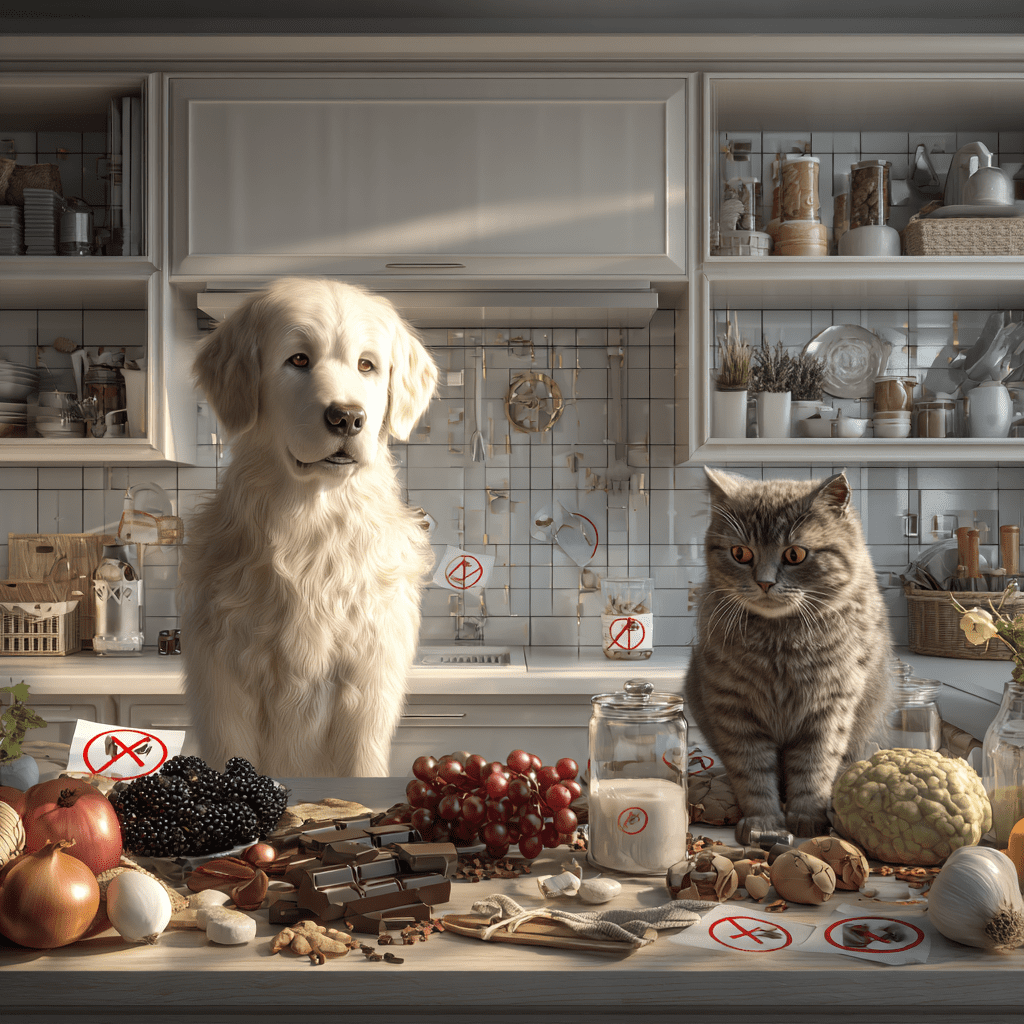Introduction: The Danger Lurking in Your Pantry
As pet parents, we often treat our furry companions like family — and that includes sharing food. But many common human foods can be toxic to pets, particularly dogs and cats. While the occasional table scrap may seem harmless, it can lead to serious health complications or even fatalities. In this comprehensive guide, we’ll uncover the most toxic foods for pets, why they’re harmful, what symptoms to watch for, and how to prevent accidental poisoning.
Section 1: Why Some Human Foods Are Toxic to Pets
Animals metabolize food differently than humans. Their digestive systems and livers can’t always process certain ingredients safely. For example, even a small amount of chocolate, harmless to us, can send a dog into cardiac arrest.
Key differences include:
- Enzymatic activity: Dogs and cats lack enzymes needed to break down certain compounds.
- Size sensitivity: Smaller body weight means a lower threshold for toxicity.
- Behavior: Pets often eat quickly and in large quantities, increasing risk.
Section 2: Top Toxic Foods for Dogs and Cats

Here’s a breakdown of the most dangerous foods, their effects, and what to do if ingestion occurs.
1. Chocolate
Why it’s toxic: Contains theobromine and caffeine, both harmful to pets.
Symptoms: Vomiting, diarrhea, increased heart rate, seizures.
Severity: High — especially dark chocolate.
Emergency tip: Seek vet help immediately.
2. Grapes and Raisins
Why they’re toxic: Unknown compound causes kidney failure in dogs.
Symptoms: Vomiting, lethargy, reduced appetite, kidney shutdown.
Severity: Very high — even a small amount can be deadly.
Emergency tip: Immediate vomiting induction by vet.
3. Onions, Garlic, Chives
Why they’re toxic: Contain thiosulfate, which damages red blood cells.
Symptoms: Weakness, anemia, dark urine, vomiting.
Severity: Moderate to high — especially dangerous for cats.
Emergency tip: Vet-administered oxygen and blood testing.
4. Alcohol
Why it’s toxic: Ethanol depresses the central nervous system.
Symptoms: Vomiting, incoordination, slow breathing, coma.
Severity: High — even a tablespoon can be dangerous.
Emergency tip: IV fluids and hospitalization.
5. Xylitol (found in sugar-free gum, candies, peanut butter)
Why it’s toxic: Causes a rapid insulin release and liver damage.
Symptoms: Hypoglycemia, weakness, tremors, seizures.
Severity: Extremely high — immediate vet visit needed.
Emergency tip: Do not wait — this is life-threatening.
6. Caffeine (coffee, tea, energy drinks)
Why it’s toxic: Stimulates the heart and nervous system.
Symptoms: Restlessness, fast breathing, seizures, heart issues.
Severity: Moderate to high depending on dose.
Emergency tip: Activated charcoal and cardiac monitoring.
7. Bones (especially cooked bones)
Why they’re dangerous: Can splinter and cause internal damage.
Symptoms: Choking, vomiting, constipation, internal bleeding.
Severity: High risk of physical injury.
Emergency tip: Surgery may be required in extreme cases.
8. Dairy Products
Why they’re problematic: Most adult pets are lactose intolerant.
Symptoms: Diarrhea, gas, upset stomach.
Severity: Low, but causes discomfort.
Emergency tip: Offer water and avoid dairy in future.
9. Avocados
Why they’re toxic: Contains persin, harmful especially to birds and some dogs.
Symptoms: Vomiting, diarrhea, breathing difficulty (rare).
Severity: Mild to moderate depending on species.
Emergency tip: Monitor closely unless symptoms persist.
10. Macadamia Nuts
Why they’re toxic: Unknown toxin affects muscle and nerve function.
Symptoms: Tremors, overheating, vomiting, weakness.
Severity: Moderate to high for dogs.
Emergency tip: Fluids and vet observation.
Section 3: Signs Your Pet May Be Suffering from Food Toxicity
Early detection can save your pet’s life. Watch out for:
- Sudden vomiting or diarrhea
- Loss of appetite
- Tremors or seizures
- Lethargy or restlessness
- Pale gums or bloody stool
Important: Call the vet or a poison hotline immediately — don’t wait for symptoms to worsen.
Section 4: What To Do If Your Pet Eats Something Toxic
- Stay calm – panic will confuse your pet and delay response.
- Identify the food – take note of quantity and time ingested.
- Call your vet – or an emergency animal poison control center:
- ASPCA Animal Poison Control: 888-426-4435 (USA)
- Pet Poison Helpline: 855-764-7661
- Do NOT induce vomiting unless directed by a professional.
- Keep packaging – this helps vets analyze the toxin.
Section 5: How to Pet-Proof Your Kitchen & Home
Simple prevention goes a long way:
- Store food in locked cabinets or sealed containers.
- Never leave leftovers unattended.
- Keep trash bins pet-proofed.
- Train pets with commands like “leave it.”
- Inform houseguests of pet safety rules.
Section 6: Healthy Alternatives for Treats
Instead of scraps, offer pet-safe options:
- For dogs: carrots, apples (no seeds), pumpkin, blueberries.
- For cats: small bits of cooked fish, catnip, freeze-dried treats.
Always consult your vet before introducing new foods.
Conclusion: Knowledge is the Best Prevention
Loving your pet means protecting them — even from the things in your pantry. By understanding what foods are toxic and taking the right precautions, you can ensure a safer, healthier environment for your furry family members. Share this guide with fellow pet lovers to spread awareness and save lives.
